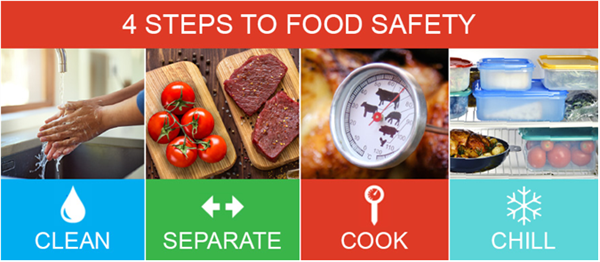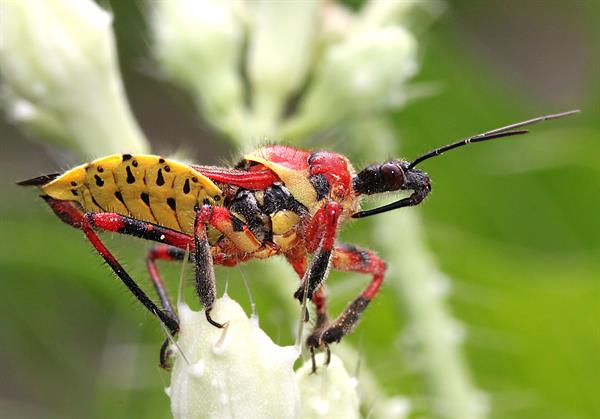
We wish everyone happy, healthy holidays with loved ones. We will be back in January 2023.
We answer your questions and provide tips about how to make sure the food we prepare at home during the holiday season is safe.
How long is fresh meat safe?
For fresh or uncooked meat products, you usually can find “sell-by” dates on the package. It is best to cook or freeze beef, pork, or lamb within 3-5 days of purchase. For fresh chicken, turkey, and ground poultry, they should be cooked or frozen within 1-2 days of purchase.

How do I safely thaw and cook frozen food?
Frozen food should be thawed in the fridge, in cold water, or in the microwave. You do need to plan ahead to thaw food safely with cold water or in the microwave.
Follow the USDA recommended food safety guidelines: https://www.fsis.usda.gov/food-safety.
What does that date mean on the food label?
The meaning of the date on your food label depends on the phrase. Here is a breakdown of what these labels usually mean:

Is that food safe to eat if it is beyond the date on the label?
Do no use infant formula beyond the date on the label. The product should generally be safe to eat if it is handled properly, up until it is clear it has become spoiled. If a food is spoiled, it will have an off odor, flavor, or texture because spoilage bacteria are naturally present in food. You should not eat food that has spoiled.
How safe is the lunch meat in my fridge?
Generally, packaged lunch meats can be kept in your fridge for 2 weeks before you open them. After you open them, they can be kept in the fridge for 3-5 days. If you are not able to eat them quickly enough, you can freeze them for 1-2 months and thaw as you need them.
I found some food in my freezer, but I am not sure how old it is. Can I use it for a meal?
Food that is kept frozen is considered to be safe indefinitely. However, it may be freezer-burned or has a different texture and odor. This does not mean it is unsafe - you can cut off freezer burn and heat it to an appropriate temperature. If the food is raw/uncooked, it can still harbor bacteria that can make you and your family sick. Make sure to follow the 4 steps (see below) to food safety and thaw raw meats in the fridge.

Check your steps:
How do I convince a young child (or anyone else) to wash their hands?
Proper handwashing takes 20 seconds, so you can make it fun by emphasizing that making bubbles helps wash away germs that can make you sick. Sing the “Happy Birthday Song” two times, which is a fun way of keeping track of the time.
If you do not have access to soap (liquid is better than bar soap if you have it), and your hands are not heavily soiled, you can use hand sanitizer with at least 60% alcohol. To use hand sanitizer properly, cover all the surfaces of your hands with hand sanitizer and rub your hands together until they are dry.

How can I keep my food safe?
References:
Food Safety Resources
Shujuan Li, Margarethe Cooper, and Channah Rock
Below is a list of federal, state, and university resources that you may have access to if you want to learn more about food safety, produce safety rules and good agricultural practices.
Food Safety Modernization Act (FSMA)
https://www.fda.gov/food/guidance-regulation-food-and-dietary-supplements/food-safety-modernization-act-fsma
Transforming the nation’s food safety system by shifting the focus from responding to foodborne illness to preventing it.
Congress enacted FSMA in response to dramatic changes in the global food system and in our understanding of foodborne illness and its consequences, including the realization that preventable foodborne illness is both a significant public health problem and a threat to the economic well-being of the food system. FDA has finalized seven major rules to implement FSMA, recognizing that ensuring the safety of the food supply is a shared responsibility among many different points in the global supply chain for both human and animal food. The FSMA rules are designed to make clear specific actions that must be taken at each of these points to prevent contamination.
Produce Safety Alliance (PSA)
https://producesafetyalliance.cornell.edu/
Providing fundamental, science-based, on-farm food safety knowledge to fresh fruit and vegetable farmers, packers, workers, regulatory personnel, and others interested in the safety of fresh produce.
The Produce Safety Alliance (PSA) is a collaboration between Cornell University, FDA, and USDA to prepare fresh produce growers to meet the regulatory requirements included in the United States Food and Drug Administration’s Food Safety Modernization Act (FSMA) Produce Safety Rule.
Indigenous Food and Agriculture Initiative (IFAI)
https://indigenousfoodandag.com/
Promoting tribal sovereignty through food and agriculture. To enhance the health and wellness of tribal communities by advancing healthy food systems, diversified economic developments, and cultural food traditions.
The Indigenous Food and Agriculture Initiative (IFAI) focuses on putting tribal sovereignty in food sovereignty, promoting tribally driven solutions to revitalize and advance traditional food systems and diversified economic development throughout Indian Country. IFAI provides Tribal governments, producers, and food businesses with educational resources, policy research, and strategic legal analysis as a foundation for building robust food economies. research, and strategic legal analysis as a foundation for building robust food economies.
Intertribal Agricultural Council (IAC)
https://www.indianag.org/
Providing a unified effort to promote change in Indian Agriculture for the benefit of Indian people.
The Intertribal Agriculture Council conducts a wide range of programs designed to further the goal of improving Indian Agriculture. The IAC promotes the Indian use of Indian resources and contracts with federal agencies to maximize resources for tribal members.
Please find the food safety related resources from your state Department of Agriculture and Universities. Below is a list of resources for Arizona residents.
The Arizona Department of Agriculture (AZDA)
https://agriculture.az.gov/plantsproduce/food-safety-modernization-act
To protect the health and safety of Arizona consumers, advance and support Arizona agriculture, and safeguard commerce.
The Arizona Department of Agriculture is to serve as a leader in ensuring consumer protection, advancing Arizona agriculture, and safeguarding agricultural commerce. The AZDA (https://agriculture.az.gov/plantsproduce/food-safety-modernization-act)
provides trainings, inspections, and collect information to maintain a current farm inventory. The Produce Safety Alliance (PSA) Produce Safety Rule (PSR) Grower Training In-Person Course is offered at a variety of locations and dates throughout the year.
The Arizona Food Safety Consortium (FSC)
https://safefood.arizona.edu/#:~:text=The%20goal%20of%20the%20Food,generation%20of%20food%20safety%20professionals
Bringing down barriers to improve food safety. Promoting food safety through collaborative research, instruction and outreach to reduce foodborne illnesses and outbreaks.
The Food Safety Consortium (FSC) consists of members from across the University of Arizona as well as from the State of Arizona Department of Agriculture and State Health Agencies. The Food Safety Consortium was formed to assist in bringing down barriers between departments, colleges and agencies in order to foster food safety related research collaborations and expand grant opportunities. Through these enhanced relationships with fellow researchers and state agencies members are better able to respond to existing as well as emerging food safety challenges.
The University of Arizona Environmental Science Food Safety Extension
https://environmentalscience.cals.arizona.edu/extension-and-outreach
Connecting with communities through outreach and extension.
Agricultural industries invest heavily to ensure that cropping and harvesting systems yield high quality, nutritious and safe foods. In addition to research, we also provide educational materials, small group trainings, and specialized outreach activities. Our faculty and Cooperative Extension lead certified grower trainings for the Food and Drug Administration Produce Safety Rule implementation across the state.
The Arizona Pest Management Center (APMC)
https://cals.arizona.edu/apmc/
The Arizona Pest Management Center (APMC) is an umbrella organization within the University of Arizona College of Agriculture and Life Sciences (CALS) whose goal is to create a working environment in which the science and implementation of Integrated Pest Management (IPM) can thrive in Arizona. The APMC provides support to CALS faculty members in their efforts to develop and deliver outstanding Integrated Pest Management programs that address the needs of Arizona’s citizens. This includes IPM programs serving agriculture, urban communities and natural areas.
The University of Arizona Public Health IPM Program
https://acis.cals.arizona.edu/community-ipm/public-health-ipm
The overall goal of the University of Arizona Public Health IPM Program is to improve human health by reducing environmental and public health risks. Thus, we develop and implement priority engaged research and Extension public health programs statewide. We are working on four program focus areas: 1. IPM in tribal communities; 2. Vector control, especially integrated mosquito, and tick management; 3. IPM in schools and housing; 4. Food safety.
We’ll Take Your Ticks

The Border Tick and Rickettsia Surveillance (BiTeRS) program of the Pacific Southwest Center of Excellence in Vector-Borne Diseases (PacVec) offers services to enhance surveillance for ticks and tick-borne pathogens of human health concern in California and Arizona. This is made possible through our project leaders at the University of California, Davis, and the University of Arizona, and collaborating local and state agencies, including the California Department of Public Health and the Arizona Department of Health Services.
We help every step of the way, and identification and pathogen testing are FREE. Collection supplies and protocols are provided, and partners receive all results on ticks they have submitted.
We work with partner organizations to:
Partner organizations may be:
Download the BiTeRS Flyer for distribution: https://pacvec.us/biters/

What the Heck was This?

Photo: Alan Schmierer
Many congratulations to the following Master Pest Detectives:
What the Heck is in my dishwasher?
Which scorpion species is this most likely to be?
I live in the Phoenix Metro area, AZ
Bonus points for speculating on how or why it is in there.

If you know the answer, email Dawn at dhgouge@arizona.edu. You will not win anything if you are correct, but you will be listed as a “Master Pest Detective” in the next newsletter issue.
Southwest Rodent Academy, 2022
The University of Arizona, in collaboration with the Arizona Pest Professional Organization, will host 2022 Southwest Rodent Academy, November 29th and 30th for pest management professionals and those who are interested in rodent management. This workshop is an in-person event at the Maricopa Agricultural Center, 37860 W. Smith-Enke Rd. Maricopa, AZ 85138. Same 6 AZ PMD CEU Hours will be provided each day. Don’t miss this great training event! Space is limited and please register here: https://www.azppo.org/event-4939380.
For more information, please contact Lucy Li at lucyli@arizona.edu.
University of Arizona Urban Horticulture Needs Assessment Survey
Please take a few minutes to complete this survey: https://uarizona.co1.qualtrics.com/jfe/form/SV_9Npt1QpCaNBWYho
Your inputs will be valuable to improve current extension programs and develop new ones that will serve the urban horticulture community better.
If you have any questions about the survey, please contact Michael Chamberland,mchamb@arizona.edu or Shaku Nair, nairs@arizona.edu.
“There’s a Fly in My Soup – IPM in Restaurants” EPA IPM webinar to be held on December 6th, 2022 (2:00 – 4:00 PM ET).
Restaurants are in business to feed people, but unfortunately, they can also be a breeding ground for pests because they provide food, water, and shelter. Restaurants are held to a high standard for managing pests by customers and their local food safety inspectors. This webinar focuses on the major pests found in restaurants (flies, cockroaches, and rodents) and the IPM tactics for their prevention and control. Flies in kitchens, food storage, service, and eating areas can cause food contamination and pose a health risk. Key species include house, fruit, and drain flies, and many others. Correct identification of flies is important and influences management decisions because different species have distinct needs and behaviors. Also discussed will be the importance of selecting a pest management service provider.
Register at: https://attendee.gotowebinar.com/register/7650471600249648652
View recordings of previous EPA Integrated Pest Management Webinars at https://www.epa.gov/managing-pests-schools/upcoming-integrated-pest-management-webinars.
For more information about the EPA Schools program: http://www.epa.gov/schools/.
To view all our previous newsletters, visit: https://acis.cals.arizona.edu/community-ipm/home-and-school-ipm-newsletters.

Designed for professionals with less than five years’ experience in pest management, the Certified IPM Technician (CIT) credential demonstrates a foundational skillset and commitment to the IPM principles and practices. Applications for the credential are now being accepted by the ESA Certification.
ESA also offers several other certification programs for professionals:
Acknowledgements
This material is in part funded by the National Institute of Food and Agriculture, U.S. Department of Agriculture, under award number 2021-70006-35385 that provides Extension IPM funding to the University of Arizona. It is funded in part by the USDA National Institute of Food and Agriculture through the Western Integrated Pest Management Center, grant number 2018-70006-28881. Additional support is provided by the UA Arizona Pest Management Center and Department of Entomology. Any opinions, findings, conclusions, or recommendations expressed in this publication are those of the authors and do not necessarily reflect the views of the U.S. Department of Agriculture or those of other funders.